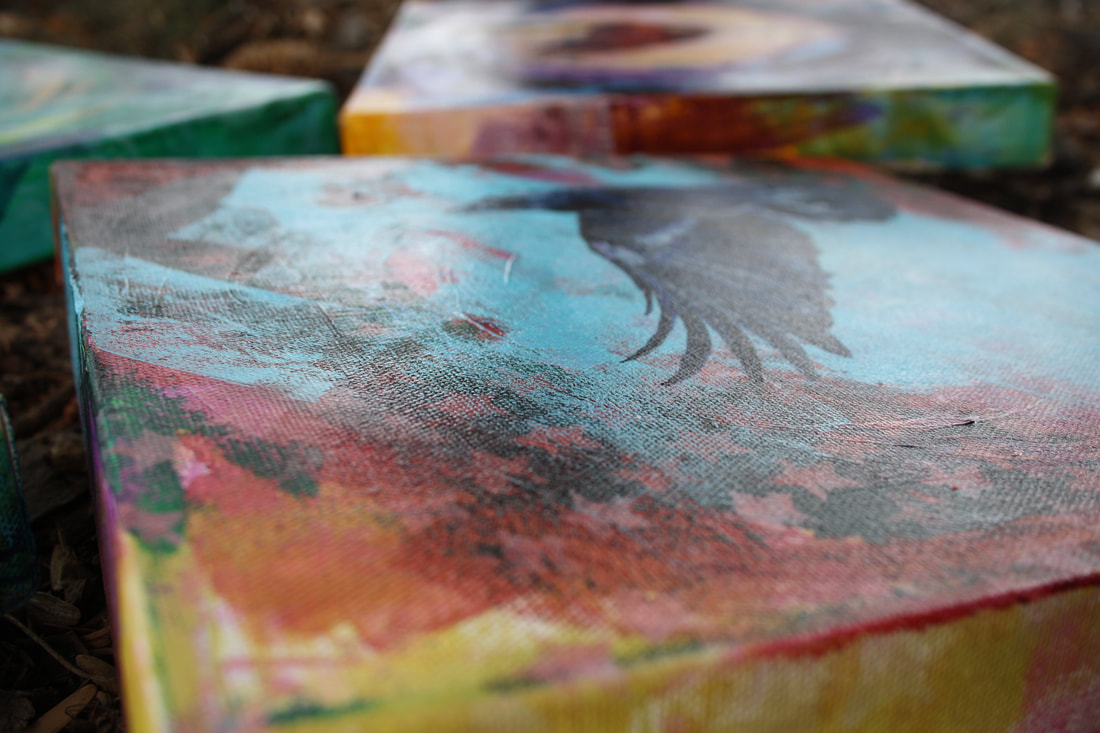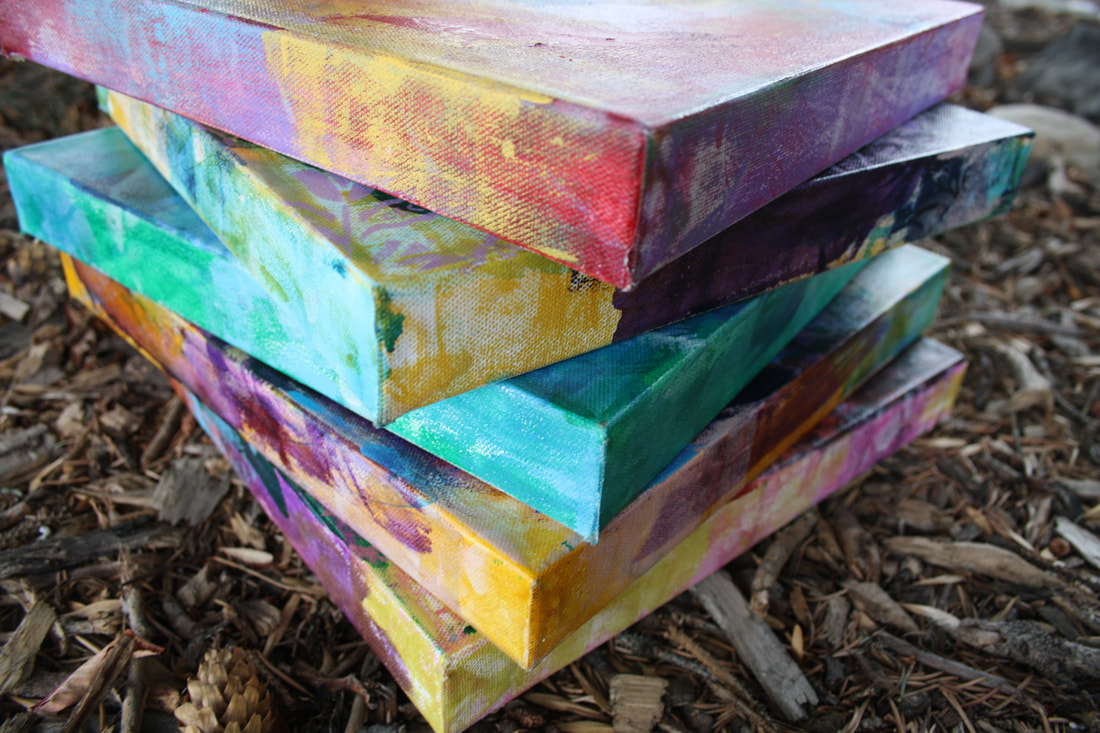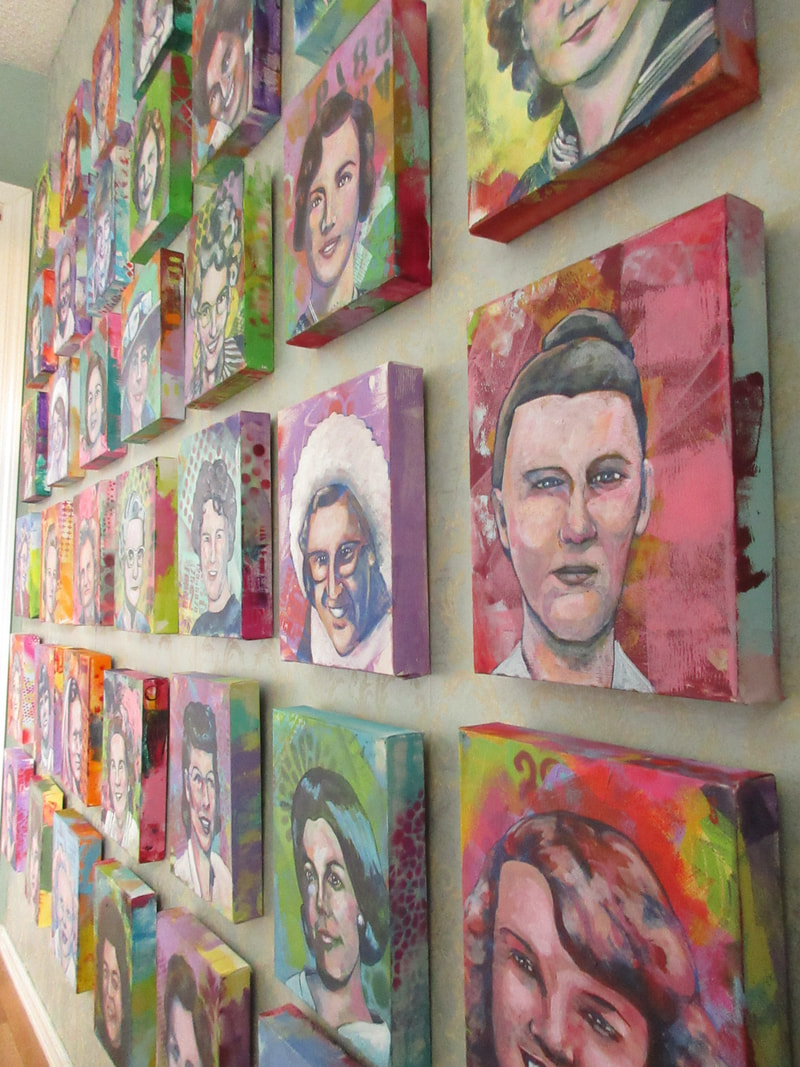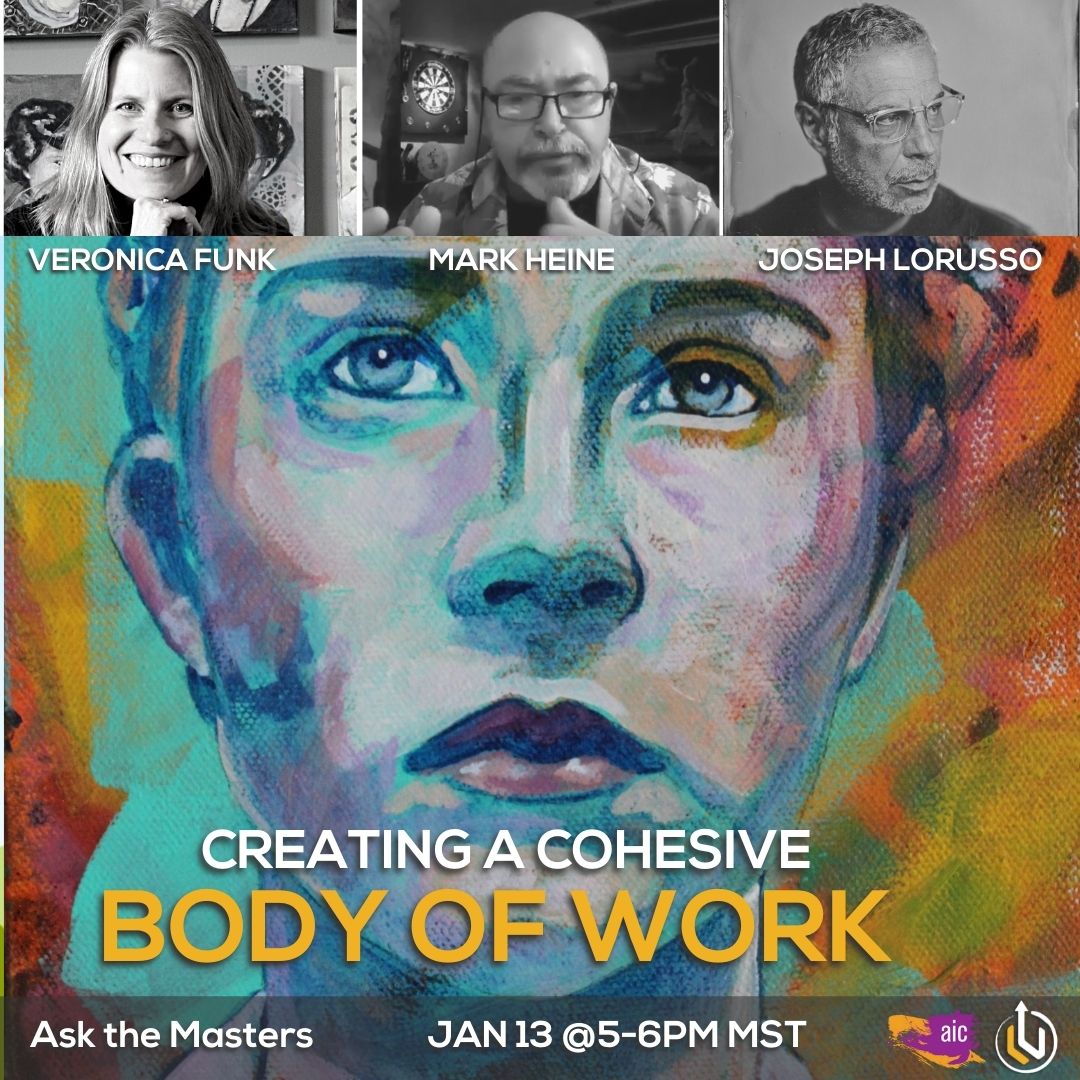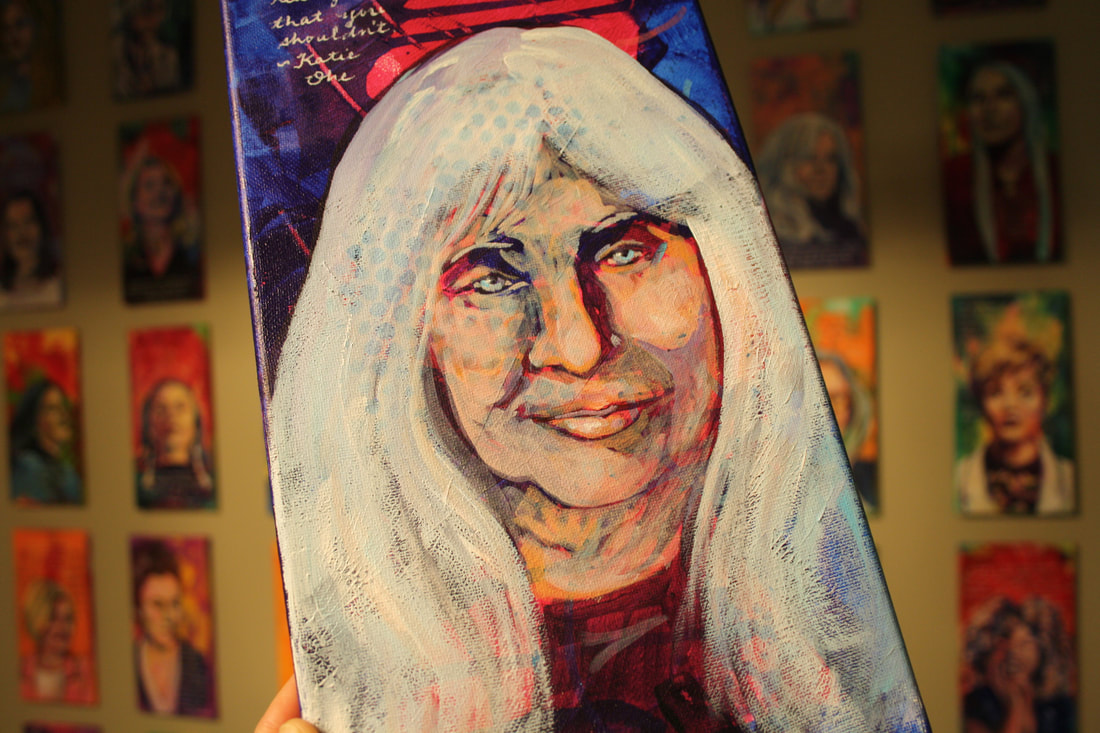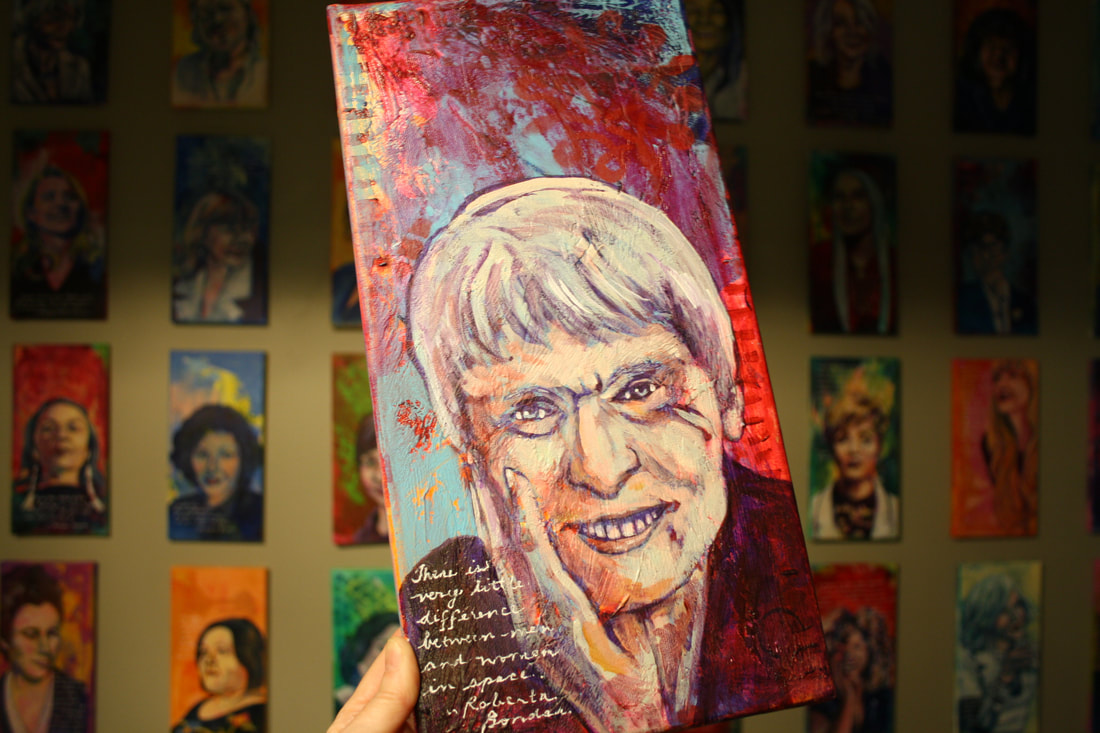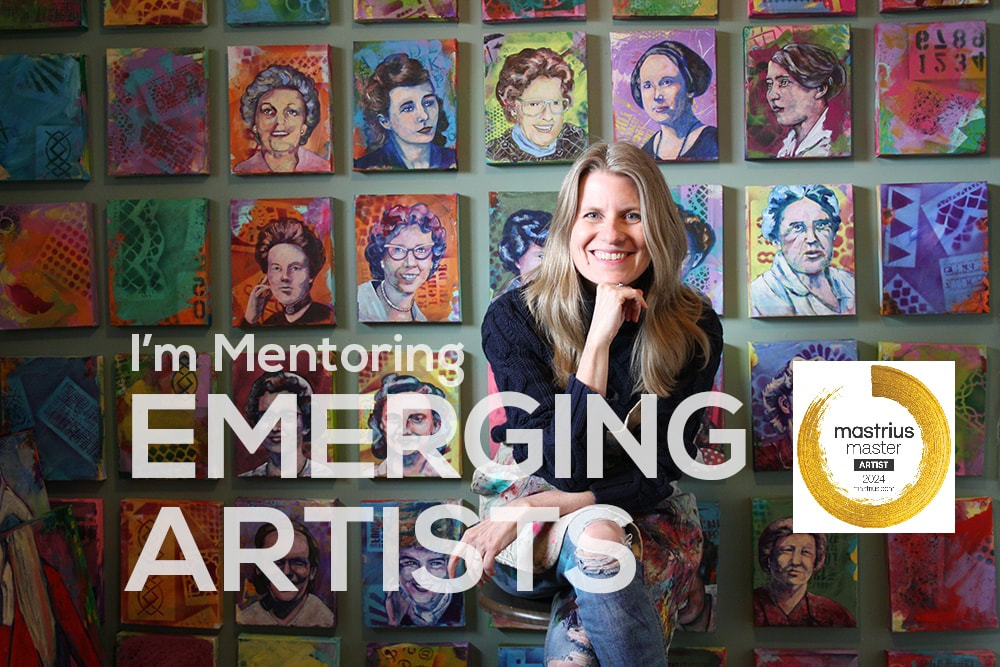|
I've really been enjoying painting the birds of Alberta lately...it all began with my husband's lifelong fascination which led to bird related birthday gifts for him last year. I picked up a bird book, a bird bath, and a beautiful hand embroidered bird created by a Calgary artist. When I was invited to take part in this year's Square Foot Show titled 'Painting the West' (February 9-11) I was unsure of what I'd paint to represent the west. On walks with my daughters over Christmas, I was excited to see all the birds along the creek near our home so I thought I'd continue my exploration of the bird paintings that I began last year. I'll begin sharing them soon!
I've been enjoying painting these little round 4-inch bees. And I tried out a new colour of the Liquitex acrylic inks...this time a muted Payne's grey. I LOVE the muted colours and my airbrush seems to love them, too (no clogging!). The grey ended up looking a little purple/blue once it was sprayed onto different background colours. I'm a fan of Payne's grey Liquitex heavy body paints and now of the acrylic ink, too.
The 'Extraordinary Women' are down and the canvases for the 'Woman's Work' project are now up. Currently there are 36 canvases ready to go and I'll wait to see how many women submit to be part of this project before adding others. I've decided to take my time this time around and really enjoy the process as I tend to 'rush' through these things. I'm excited about it as there are several things happening over the next few months...all wonderful!
I'm down to wiring and varnishing my contribution for the 'Square Foot Show' that will be taking place online in February. It's been busy in my little studio as I'm about to begin the upcoming 'Woman's Work' project, need to wire & varnish the 'Extraordinary Women' project, have started my final art history class (very interesting...Art & Ecojustice), packing paintings to ship to exhibits at the Federation Gallery in Vancouver, am preparing for my art retreat at the Banff Boutique Inn next month, and have just signed on with the leadership of LevellingUp. It is such an amazing group of encouraging people with the focus on Artists Supporting Artists...love that so much. So, please wish me luck...I think I might need it to stay on top of everything. :)
I am excited to be joining Alberta artist Julie DeBoer in the upcoming online Square Foot Show hosted by Ontario artist Julia Veenstra. I've been inspired by walks with my girls over the holiday and am really looking forward to this.
The show will take place online February 9 to 11 with every painting available measuring 12x12 inches and listed at only $300 each. Apparently everything goes very quickly so they do recommend being prepared for the start at 8pm EST on the 9th and paintings are packaged and shipped beginning on February 14. I'm currently working on 5 piece and will begin sharing what will be available soon. Today 'The Grandmothers' are finally heading out for exhibit at the Leighton Art Centre. This has been a long road and, fingers crossed, there will be an exhibit reception on February 5 at 2pm. The art centre is set in a beautiful historical home on a rolling landscape with mountain views and was launched by artist Barbara Leighton:
At ACAD she found the support of young artists who were attracted to the Leighton history and the artistic and natural wealth of their home and property. In 1970 Barbara sold half of her quarter-section to invest in the purchase for $1,000 of the abandoned 1919 Ballyhamage one-room schoolhouse. Her friends pitched in to help restore the old schoolhouse and convert it to an art studio. A few years later, a weaving studio and pottery studio were added, but the red one-room schoolhouse remains to this day the heart of the Centre’s children’s programs. In 1974 with the support of her friends, Barbara officially opened the Leighton Centre. The Centre had quickly become a gathering place for budding and professional artists and children. Many had come to discover their artistic talents by exploring the beauty found in the Leightons’ home and surrounding fields. Barbara turned her home into a gallery and museum so that she could exhibit A.C.’s paintings, as well as works by other prominent Alberta artists such as Stan Perrott, Barbara Ballachey, Jim and Marion Nicoll, Rick Grandmaison, Janet Mitchell, Roland Gissing, lllingworth Kerr, and sculptor Richard Roenisch. I feel so honoured to have my work exhibited here...and, especially 'The Grandmothers.' 'Home Again' / 6x8 (framed) / acrylic on panel
FEDERATION GALLERY 1241 Cartwright Street, Vancouver, V6H 4B7 January 3 - 23, 2022 To view the exhibit online, please visit: https://federationgallery.com/exhibit/2022_active_member_exhibition/3258 Live panel discussion: Creating a cohesive body of work
Thursday January 13, 5-6pm MT 🚩 Go to @levellingup to learn more. Join me and fellow @levellingup Masters @markdavidheine and @lorussoarts for a LIVE panel discussion. Let's talk about how creating a cohesive body of work can bring your art career to a new level. We'll answer the big questions, like: 🟣 What is an artistic body of work? 🟣 Why do you need to create a body of work? How can a body of work influence your art career? 🟣 How can you start creating a cohesive body of work? Is it the subject matter I choose, my painting style, my color choices? Tickets are $10 (free for LU members). 🚩 Go to LevellingUp to learn more. I want my sculptures to induce or to invoke touch before you really think that you shouldn't. Active in the Calgary arts community since the mid-1950s, when she began her formal arts education at the Provincial Institute of Technology and Art, (now the Alberta University of the Arts,) Ohe subsequently pursued training in Montreal, New York City, and Verona. In the early 1960s, a time when a tradition of European landscape painting still had a stronghold on the artistic production in the province, and very few artists were making sculpture at all, Ohe became one of the first artists in Alberta to make abstract sculpture. She began to utilize a variety of new materials, skills, and techniques, including the use of pre-fabricated objects and industrial processes. Through her work and her teaching practice, (she taught at the Alberta College of Art and Design from the early 1960s until her retirement in 2016,) Ohe became a major influence on the sculptural practice in the region.
Embracing elements of reductive geometry, repetition, and visual harmony, Ohe has developed a body of work that is at once connected to Minimalism through its purity and unity of form, but is also affective, idiosyncratic, sensual, and concerned with personal experience, memory, and the perception of the natural world. She is perhaps best known for her masterful kinetic sculptures. Beginning in the early 1970s, after much thought and experimentation with ways to rise above familiar heavy and static sculptural forms to achieve a sense of weightlessness, dynamism, fluidity, and optical confusion, Ohe perceived that changes in sculptural configuration through movement coupled with a viewer’s physical and physiological interaction would be essential in realizing these goals. To that end, much of her work since that point is distinguished by its radically tactile nature. The quality of surface became inextricably important to the success of her sculptures; works such as Horizontal Loops (1973), Zipper (1975), Upper Flow (1975-76), and Venetian Puddle (1977-78) were chromed and polished to a perfect, seductive smoothness, which would, as Ohe often remarks, “induce or provoke touch before you think that you really shouldn’t.” Movement introduces an integral element to the space within and surrounding the sculptures, which in turn influences the perception of their form. Combinations of undulating, spiralling, fluidly shimmering and reflective shapes generate a sense of visual instability and optical uncertainty—and also a sense of humour and playfulness—which makes the viewer and their experience an essential part of the work. The 1980s introduced other external influences to her oeuvre and generated new ways of thinking and making. The ambitiously scaled installation, Skyblock (1981-82), a configuration of suspended horizontal bars branching into a spiral herringbone pattern, was originally designed as a proposal for a public commission in the Gulf Canada Building. The work was conceived as a way to bring the viewer within an immersive environment of reflective material and into a physical relationship with the idea of an infinitely changing linear pattern. Although Ohe didn’t receive the public commission, she proceeded to fabricate the work on a smaller scale. In 1983, Ohe travelled to Japan and there drew insight from traditional rock gardens and their elemental sense of contemplation. Kinetic works from the mid-1980s to early 1990s, such as Drummer Boys (1988) and works from the Guardian series deployed new, more earthy materials such as cast and tinted aluminum and aggregate stone, which introduced a shift toward a warmer, textured surface and a more diffuse and softer reflection of light. These works are both more elemental and more figurative, and movement is principled on the contemplatively rhythmic swing of ringed pendulums. Ohe’s floor-based series of works such as Typhoon (1984), Monsoon (2006, 2011), and Chuckles (2015) utilize powder coating and colour to induce intuitive touch. The collective movement of these groupings emphasizes the importance of the space around the sculptures, their relationship to each other, and to the viewer. When the sculptures are collectively in motion, their unique movements and spatial relationships generate a situation wherein the mind and eye cannot immediately comprehend the logic of form and space. Although they appear simple and minimal, each of Ohe’s works is extremely labour intensive and technically precise. Their creation often involves years of experimentation, trial and error, engineering, and fabrication to create the correct effect and affect through movement. Her sculptures have agency; they are active, vital, and compel you to touch them. Ohe’s work reminds us that seeing is not the only form of perceiving our environment; that the relationship among the visual, physical, poetic, and psychological compose a way of knowing the world rooted in comprehensive and intellectual challenge and disruption. ~ Esker Foundation There is very little difference between men and women in space. Roberta was interested in space as a child: “When I was eight years old, to be a spaceman was the most exciting thing I could imagine.” She was given a camera when she was young, which sparked her interest in photography. She was involved in sports, Girls Guides, the YMCA, and church groups in her youth.
Bondar was also very interested in science; her father built a laboratory in their basement so she could conduct experiments. She led the science team at her high school (Sir James Dunn Collegiate and Vocational School) and received honourable mention at the Canada Wide Science Fair in Grade 13. Bondar spent summers working as a science researcher with the federal Department of Fisheries and Forestry in Sault Ste Marie. Her high school guidance counsellor tried to dissuade her from pursuing science in university, believing that it wasn’t a subject for girls, but Bondar persisted. Bondar attended the University of Guelph, where she completed a Bachelor of Science in zoology and agriculture in 1968. During this time, she also received her pilot’s license. She continued in higher education, earning a Master of Science in experimental pathology from the University of Western Ontario in 1971, a PhD in neuroscience from the University of Toronto in 1974, and a Doctor of Medicine from McMaster University in 1977. Roberta Bondar worked as a clinical science researcher and neurologist, a doctor who specializes in the nervous system. She completed post-graduate work at Toronto General Hospital, the University of Western Ontario, Tufts New England Medical Center (Boston), the Playfair Neuroscience Unit of Toronto Western Hospital, and the Pacific Vascular Institute (Seattle). She was admitted as a Fellow to the Royal College of Physicians in 1981 for neurology. Bondar was an assistant professor of medicine (neurology) at McMaster University from 1982 to 1984. In 1983, the National Research Council of Canada created the Canadian Astronaut Program (now part of the Canadian Space Agency) to recruit Canada’s first astronauts. Roberta Bondar applied immediately. After six months of interviews and tests, she was chosen as one of six Canadians admitted to the program (see Canadian Astronauts). Her research and clinical work on the nervous system had immediate relevance to experiments planned for the first Canadian spaceflight. On 22 January 1992, Roberta Bondar became the first Canadian woman, the second Canadian, and the first neurologist in space. She flew aboard space shuttle Discovery, the only Canadian and woman of the seven crew members of NASA Mission STS-42. The mission was originally planned to last ten days, but changes in shuttles due to repairs shortened it to seven days. On the sixth day after launch, enough fuel remained to extend the mission to eight days. Being in space with low gravity meant that the astronauts had to adjust to changes in their bodies. In such weightless conditions, astronauts’ spines can lengthen by as much as 2–4 cm, which can cause back pains for some. Bondar reported that she didn’t need her glasses while in space, likely because of the effect of microgravity on the eye’s fluids. This was fortunate, as her glasses had floated away and become lost early in the mission. After 129 orbits around Earth, Discovery landed in California on 30 January 1992. The astronauts then underwent testing to compare how their bodies responded to conditions in space versus conditions on Earth. Bondar left the Canadian Space Agency on 4 September 1992. She continued to pursue her research in space medicine and led NASA research teams that studied data from spaceflights to apply to medicine on Earth. ~ Laura Neilson Bonikowsky & Emily Gwiazda |
|
